We all know the expression: 'garbage in; garbage out'. When it comes to making music on your computer choosing a good great audio interface is hugely important if you want to get the highest quality sound in and out of your computer.
But with so many makes and models on the market where do you even begin? And what do you need to look for in an audio interface? And do you even need one?
Good question. Let's start there.
Do I Actually Need An Audio Interface?
That depends on what kind of music you produce, and how you want to listen to it. If you're an in-the-box kind of person, who likes mixing on their headphones, then you could get by with just using a USB-Midi controller for input and the headphone jack on your laptop or PC.
If you want to record instruments or voices, you'll need a way to get that analog signal into your computer. Additionally, you'll need a way to monitor your recording.
And if you want to p**s off dazzle your roommates with your creation you'll need a way to hook up your boombastic speakers to let the world know it's time to get louuuuddddddd.
For a more detailed look at what an audio interface actually does check out this article . I'll be waiting here when you're done.
Ready? Alright, so what do you need to look for when choosing between audio interfaces?
Things To Consider
Again this depends on what kind of music you make, and how you make it.
Connectivity
First of all, you'll want to decide how you'll connect with your computer. If you have a spare USB port you can choose from one of the many models out there. USB interfaces are by far the most common way to hook up an audio interface to your 'pooter, especially as technology improves transfer speeds. If you have Thunderbolt ports that opens up more options, and if you're still clinging on to Firewire there are some options there too.
Inputs
Next, you'll want to think about how many inputs you'll need. If you're a one-woman home studio recording tracks one at a time, a single input will suffice. For multi-track recording, you'll need more inputs.
If you're recording a signal from an instrument, like that dusty Korg M1 in the corner, you'll need at least one instrument input. Rocking out through a Marshall stack and capturing it with some well-placed mics? You'll need a mic input, and phantom power if it's a condenser microphone. If you're using USB microphones to record note that these won't be part of the signal path of the interface.
Outputs
Similarly, consider where the output signal of the audio interface is going. If you're hooking up a pair of studio monitors you'll need to make sure the outputs of the interface are compatible with the inputs of your monitors.
Will you be using external preamps, or effects processing? You'll need additional outputs for these.
Headphone Outputs
For monitoring purposes, you'll need headphone outputs. How many you need depends on the number of people who will be recording at the same time. Most audio interfaces come with at least one.
MIDI
Do you need midi connectivity? MIDI keyboards now can plug directly into one of your computer's other USB ports, but if you have an older keyboard you'll need an audio interface that allows you to connect via old-school midi cables.
Software Bundles
Pretty much any audio interface will come with some form of a software bundle. While this alone shouldn't be the deciding factor in which model you choose, it's worth taking a moment to see if the freebies that come with the interface will be of real value to you. For instance, if you already own the Native Instruments Komplete collection the included software with their interfaces won't be of much use to you, but the ones on offer from Universal Audio might.
Future Growth
Something worth adding here is thinking about how your studio needs might change in the future. If you look into your crystal ball and see growth, it may be wise to think bigger when choosing an audio interface.
With all those considerations to keep in mind, what are the best audio interfaces on the market?
10 Best Audio Interfaces For 2022
1. Universal Audio Apollo x8 Heritage Edition 18 x 24 Thunderbolt 3 Audio Interface with UAD DSP

Universal Audio have long been regarded as one of the leaders in the audio interface field, and this beast comes with 50% more processing power than previous Apollo models. As you'd expect it comes with a price tag to match, but as one of the more advanced interfaces on the market this comes with pretty much everything you need for nearly any kind of recording session.
With the speedy Thunderbolt 3 connection, you're guaranteed ultra-low latency, leaving you to focus on the performance being captured. Speaking of capturing performances you have options here: 4 XLR mic/line inputs, 8 1/4" hi-Z inputs, and 8 1/4" line inputs, plus S/PDIF, and 2 Optical Toslink connections for the digital users.
The AD/DA converters are clean, with a large dynamic range, and the preamps (6 in total: 4 mic and 2 instrument) are complimented with Unison technology. Rather than being stuck with the preamp that came with your audio interface, you can now track through models of legendary industry preamps.
Onboard DSP processing reduces strain on your workstation, and 7.1 surround monitoring support means this unit is also great for engineers working in video games, film, and television.
And all this before you even get to the included software - a collection of some of UADs finest plugins to use in your production. It could be a marketing ploy, but they claim the bundle is worth nearly half the value of the interface.
Notable Features
- 18 inputs / 24 outputs
- Two headphone jacks
- 4 microphone preamps
- 3 digital inputs and outputs (including an optical input)
- Onboard DSP (digital signal processing) 6 cores
- 7.1 surround monitoring support
Reasons To Buy
- Excellent software bundle
- Onboard DSP processing
- Allows for studio growth
Reasons To Avoid
- Hefty price tag
- Not portable
- Thunderbolt connectivity only
My Verdict
If you're in need of a top-quality audio interface with multiple inputs and outputs and premium AD/DA conversion (and you have the cash to spare), this one is for you. If you want the UAD sound without quite the same cost consider the Universal Audio Apollo Twin
2. Native Instruments Komplete Audio 6 Mk2 USB Audio Interface
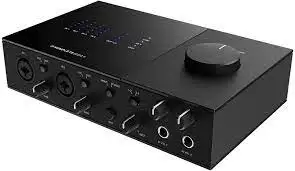
Native Instruments has long been known for its impressive software line. Then came the midi controllers, and now they're dabbling in the world of audio interfaces. The Audio 6 is one in a series of Komplete Audio boxes, with varying degrees of connectivity.
Touted as being compatible for both stage and studio due to its size and rugged build, this simple-looking audio interface is both affordable and versatile.
The Mk2 is bus-powered, so you won't need to find a spare socket to plug it in, but you will need a free USB port. The two front-facing ports are mic/line inputs, and of course, there's phantom power available if you need it. Two more line inputs are around the back, along with the stereo digital in/out, four balanced line outputs, and MIDI in/out.
There's the option to use a direct monitoring system so you can record with no latency. The downside of this is you won't have the benefit of hearing any onboard processing you have set up in your DAW. For the price though that's to be expected.
The two headphone outputs have independent level controls, and the 4 line outs mean you can utilize some external processing if you want it.
But since Native Instruments aren't well known for being audio processing pioneers, what pushes this model on the best buy list? For me, it's the plethora of software that comes with the box. In addition to a generous selection from the infamous Komplete series of instruments and effects, owners also get two e-vouchers to spend at the Native Instruments store and a copy of Ableton Live 10 Lite.
Notable Features
- Independent headphone outputs
- Phantom power
- Midi in/out
- USB bus power
- Digital in/out
- 2 independent headphone jacks
- Direct monitoring
Reasons To Buy
- With the included software and your laptop, you'll have a tidy little rig for recording anywhere
- USB powered, so useful for mobile/on the road recording
- Great for hooking up synths with S/PDIF coaxial connections
Reasons To Avoid
- Metering system on top of the box
- No scaling on controls
My Verdict
If you're just starting out and looking to beef up your studio software this is a solid entry-level audio interface.
3. Solid State Logic SSL2+ USB Audio Interface
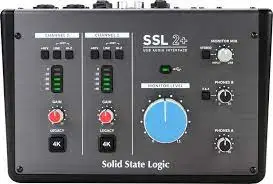
Solid State Logic has a long history in the audio recording world, and most engineers lust over the sexy consoles seen in large studios. Now you can own a piece of the SSL pie without selling family members for body parts, and get a tidy audio interface to boot!
The preamps on this interface are described in the marketing blurb as being 'pro-grade', and with a company like Solid State Logic that's no hyperbole. The AD/DA converters from AKM = are also top-notch.
One thing worth noting here is the 'Legacy 4k' feature, which is a magic button that makes your signal sound like it's traveling along an old-school analog signal path, complete with subtle harmonic distortion. Based on the sound of the SSL 4000 series console this button will push vocals and instruments forward in the mix and give a deeper, richer sound.
With only two XLR-1/4" inputs this box is geared more towards the solo artist or bedroom producer, and all the ins and outs of this interface are housed around the back. This may prove to be a bit niggly if you like to switch between multiple sources. Having two headphone outputs is a nice touch, especially on such a small piece of gear. The 'B' phones are linked to outputs 3+4, allowing you to switch between two different headphone mixes. MIDI in/out is also a handy addition so you can hook up your favorite outboard synth.
While the inputs and outputs are limited, you get unrivaled sound quality, a sturdy build (no more crappy plastic knobs falling off), and of course a software bundle, including plugins from SSL and third parties. For the bedroom producer with impeccable sonic standards, this could be all the box you need!
Notable Features
- Dual headphone outputs
- 2 x XLR-1/4" combo mic/line inputs
- USB bus power
- 4 line outputs
- Legcay 4K button
Reasons To Buy
- Instant analog-sounding recordings at the touch of a button
- SSL software bundle included
Reasons To Avoid
- Only two inputs
My Verdict
The input-to-price ratio isn't great, but considering the quality of the build and unique solid-state logic sound quality, this is a serious contender for the best audio interface for solo artists award.
4. IK Multimedia iRig Pro Duo I/O
Another software company ventures into the audio interface market (and of course offers bundled software to up-sell at a later stage)! Don't be put off by the size of this interface; it comes with Jordan Rudess' blessing, and if it's good enough for him to use on the road, it's worth considering for anyone making music on the move.
This unit is designed for the mobile musician, not as a serious desktop contender. It's battery-powered and small enough to take up an unassuming amount of space in your backpack or gig bag.
There are two mic/line combo inputs, complete with Class-A pre-amps, and phantom power so you can still work with your favorite condenser mic.
On the output front, you have two 1/4" TRS sockets and a 3.5mm headphone jack. Data is transferred via a Mini-DIN socket, and IK Multimedia helpfully includes cables to connect to lightning, USB-C, and USB-A ports. So whether you're recording on to an iOs or Android device, or Mac or PC you'll be able to get up and running straight out of the box.
Connection to MIDI is (sort of) provided via 2.5mm I/O jacks. Thankfully the breakout cables are included so there are no hidden costs to connect a synth to your rig.
Power comes from an option of two AA batteries, USB bus power (via the mini-DINN), or a 9V DC power supply, which is sold separately. Some musicians have bemoaned the fact that if you're using the Pro Duo with an iPad you need to purchase a 'power bridge' in order to prevent battery drain on the iPad. So if you are planning on using this as a live solution, be aware!
Notable Features
- 2 combo mic/instrument inputs
- 1/4" TRS outputs
- Compatible with Android and iOS devices, as well as Mac and PC
- Class A mic preamps
Reasons To Buy
- Ultra-compact unit for the live musician
Reasons To Avoid
- Fiddly controls
- Headphone output only 3.5mm
- Plenty of better options if you don't need the portability
My Verdict
I'd consider this more of a supplemental audio interface than one to use in your main studio. If you do location recording/filming or spend a lot of time on the road this is worth a look when considering portable interfaces. For any budding Bob Dylans who do a lot of live work and want a smaller rig to carry around this could be the best audio interface for guitar.
5. PreSonus Studio 68c USB-C Audio Interface
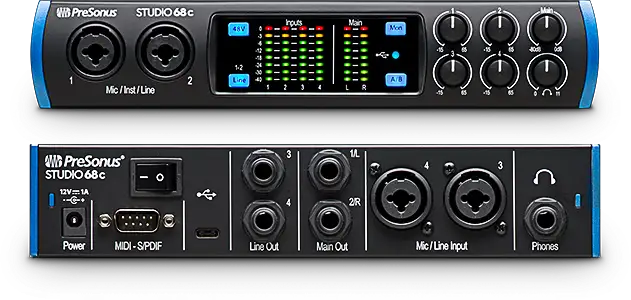
This compact little gem from PreSonus is ideal for project studios, small bands, or producers, with digital and MIDI connections, and a tasty software bundle to boot.
The front interface includes two mic/instrument/line connections, with a further two around the back. These are all powered by XMAX preamps which provide plenty of headroom and just the right amount of warmth to add sweetness to your recordings.
Additional front panel controls include the headphone volume, main volume, and an A/B button for switching between monitor mixes. The metering display is a great size for keeping an eye on your input and output levels - something that is often missing from smaller desktop interfaces.
The rear of the unit has four line outputs for those of you who may want to take advantage of external effects processing, or need that extra monitoring flexibility. It's also where the headphone jack lives, which isn't the most useful positioning for use in a live situation. Digital and MIDI connection is via a single serial connector. Breakout cables are included but you can only run MIDI or S/PDIF, not both together, since there's only one connection. Power is also connected at the rear as you'd expect, with a 12V DC supply, and USB-C connects you to your DAW.
The Studio 68c is compatible with Apple's Silicon-based Macs and iOS devices, meaning it's great for plugging into your iMac for recording sessions, or for capturing a podcast in your iPad mini.
The ubiquitous software bundle comes with the 'Artist' edition of Studio One, a Studio Magic plug-in suite, and a collection of other effects that are compatible with any DAW.
If you're crafty you can bag a package on Amazon which includes cables, headphones, pop filter, and boom arm.
Notable Features
- 6 simultaneous inputs and outputs
- Digital in/out
- 4 XMAX Class A microphone preamps
- USB Connectivity
- 12V DC power supply (included)
- Low-latency direct monitoring
Reasons To Buy
- Cue mix A/B function for toggling between two mixes - handy for DJs
Reasons To Avoid
- Not a true 6-in interface if you're using the S/PDIF connection for MIDI
My Verdict
This is another one of those compact audio interfaces whose size belies its capabilities. Definitely worth considering if you're a producer recording bands and need a handful of simultaneous inputs and flexibility for monitoring.
6. Focusrite Scarlett 2i2 3rd Gen USB Audio Interface
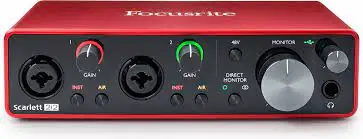
Focusrite have a history of making best-selling products, and this third-generation model is one of the most popular audio interfaces on the market today. It's not hard to see why, with its sleek red exterior, combo inputs, and magic 'air' button. It's pretty rugged too so you can use it as a mobile rig.
The front of this USB interface houses the two combo inputs along with a headphone output, volume and gain controls, phantom power switch, and direct monitor button. Also on this panel is a magic 'Air' button. Modeled on Focusrite's ISA console transformer this effect gives your recordings a brighter, more open sound.
Around the back, you'll find the USB-C connection, from which the unit draws power, and the solitary L/R out. This coupled with the single headphone jack, and limited input options mean that while the quality of sound is great, this interface is more suited to the solo musician or bedroom producer. There's also no MIDI or digital connectivity on this model.
A redeeming factor is the support for iPad Pros via the USB-C port, making it a handy unit for budding podcasters, or singer-songwriters who like to find their inspiration on the fly. There's also a decent bunch of software that comes with the unit, including Focusrite native and 3rd party plug-ins, Ableton Live Lite, and a 3-month subscription to Splice and Avid Pro Tools.
Despite the limited in/out capability, the price makes the Focusrite 2i2 a solid contender for musicians who need a simple audio interface solution that delivers quality results.
Notable Features
- 2 mic preamps
- 2 balanced inputs
- Balanced TRS outputs
- Included recording software, instruments, and effects
- 3-month subscription to Splice Sounds included
Reasons To Buy
- Nifty little 'Air' button
- Solid performance for both desktop and mobile rigs
Reasons To Avoid
- Limited outputs
My Verdict
For the smaller producer or a solo artist, this in my opinion is the best budget audio interface. Your recordings will sound pristine, and you'll have a choice array of plug-ins to add to your work. Sure, you may need more inputs and outputs later on in your career path, but the price of this model will leave some in the bank for future splurges.
7. Focusrite Scarlett 18i20 3rd Gen USB Audio Interface
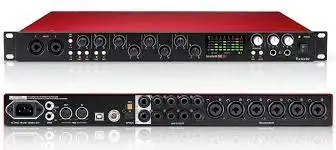
Sticking with the sexy red theme but this time for folks who need more input channels. Like the Universal Audio unit further up the page, this Focusrite unit boasts enough input and output capability to make it a worthwhile consideration for the project studio.
The front panel of this rack-mount unit houses two combo inputs, a dedicated power switch, headphone sockets and controls, input settings for all 8 channels, and an eight-channel LED bar-graph display.
The rear of the unit is where more of the grunt work happens. A further six mic/line inputs sit next to a generous ten-line output, giving you plenty of options for additional preamps, external signal processing, or monitoring options. There's also MIDI in/out, a word clock connection, S/PDIF in/out, and optical inputs and outputs. These optical connections mean a studio can really bump up its recording and mixing capabilities with an additional mic pre.
Other features that make this a contender for the crown of the best audio interface include a built-in talkback mic, independent level controls on the headphones, and low latency monitoring. Add two virtual loopback inputs to make streaming, podcasting, and sampling super easy, and for the price, this is an amazing piece of kit.
The 18i20 comes with the same software collection as the 2i2, but at this level, it's unlikely to be a deciding factor when choosing between audio interfaces.
Notable Features
- LED bar graph meters
- 4 monitor outputs
- Internal power supply
- Onboard talkback functionality
- ADAT Optical, S/PDIF, MIDI, and word clock out connections
- Two independent headphone outputs
Reasons To Buy
- Virtual loopback feature for streamers/podcasters
- Comprehensive in/out options, including XLR combo, MIDI, and digital
- Did I mention the 'Air' button?
Reasons To Avoid
- Headphone outputs share the same signal path as the last four outputs
My Verdict
While the price of this unit isn't budget-friendly, you get a considerable bang for your buck when you look at all the features. This is high up on the list of desktop interfaces, and the virtual loopback feature is one of the best USB audio interfaces for streaming.
8. Behringer U-Phoria UM202HD USB Audio Interface
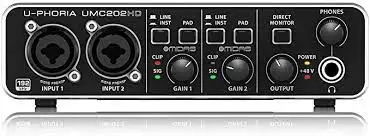
For musicians looking for the best audio interface under $100, this Behringer will give you a run for your money.
Small but mighty is the secret to this entry-level audio interface, which can record at up to 24-bit/192kHz resolution. The front panel houses most of the gubbins on this unit, while the rear of the box has the single L/R out, USB connection, and oddly the +48V phantom power. I have to admit this makes it a bit of a faff to engage the phantom power when other units have a button on the front panel. But again, the UM202 leaves the building for less than a Benjamin, so some compromises have to be made.
Back to the front. Two combo inputs have individual gain controls, and a pad button each. The single headphone output can make use of the direct monitor button to provide latency-free input monitoring. An LED light indicates power (drawn from the USB connection), and another indicates the +48V power is on (so you don't have to peer around the back to check I guess).
The included software is limited to Tracktion for a DAW, and 150 downloadable instrument and effect plug-ins. Honestly, this is not a great selling point. If you're on a budget you're probably better off trying out Reaper for a DAW, and making use of the gazillion free (but good) plug-ins out there for sounds and effects.
Software bundle aside, while this is a simple piece it's perfect for the singer/songwriter looking to do some home recording on a limited budget.
Notable Features
- +48V Phantom power
- Two mic/line combo inputs
- 24-bit/192kHz A/D Resolution
Reasons To Buy
- Great for the budget musician
Reasons To Avoid
- No MIDI connectivity
My Verdict
This unit has a decent MIDAS mic preamp for each of the two mic inputs, and coupled with its sturdy build and ease of use makes it a good choice for the musician looking to delve into home recording without hammering his credit card.
9. MOTU M4 4x4 USB-C Audio Interface

Another desktop USB interface with loopback features for all the live-streamers and podcasters out there!
This is one of a range of USB audio interfaces from MOTU HQ. Boasting ESS Sabre 32 Ultra DAC technology this interface delivers high-quality sound on a budget, with a large dynamic range to boot.
The front of this model houses two combo jacks for mic or line input, with individual gain adjustment and mic preamps. There's also a nice chunky monitor volume knob (is it me or is there something innately satisfying about having a big dial to control the volume of your work?). An LCD screen gives a comprehensive view of your input and output monitoring and is a nice addition to such a small unit.
Round the back, you have 2 more inputs - great if you want to use external preamps. The monitor connection options include both TRS stereo outputs for studio monitors and RCA connections for smaller speakers.
Dedicated MIDI ports are also housed on the rear of the unit, along with the USB-C port. Another nice feature is the power switch, meaning if you're not actively using the unit you can prevent it from draining your laptop battery while you check your emails (or play Minecraft).
The software bundle that is ubiquitous with most interfaces includes Ableton Live Lite, and 6GB of loops and sounds from Big Fish Audio, Lucid Samples, and Loopmasters. The addition of MOTU Performer Lite is a bit of a non-sequitur in the audio interface world. Ableton is great, and if you prefer traditional linear methods of producing music there are better options out there.
Notable Features
- Full-color LCD metering display
- The software bundle includes Ableton Live 10, and a whole host of bundled loops and sounds.
- MIDI In/Out
- Loopback channels for podcasting/streaming
Reasons To Buy
- Loopback functionality
- 6GB free loops and samples
Reasons To Avoid
- Only one headphone jack
My Verdict
This unit looks great and performs well. For the price, I'd like to see another headphone jack at least, and there's not a whole lot of room for growth. On the other hand with it being USB bus-powered it's a nifty portable interface for recording small ensembles - great for the roaming producer!
10. RME Fireface UFX+ USB 3.0 & Thunderbolt Audio Interface

The RMX Fireface UFX is one hefty monster of a machine, and the cost is not for the faint of heart. But we can all dream, right?
Designed for the multitrack studio the Fireface boasts a whopping 188 channels of in/out connectivity. Bear in mind this includes the analog, ADAT, MADI, and AES connections. To be more modest about it, there are 12 analog inputs, four of which can be used for mics.
In addition to the four mic/line ins on the front panel, there are two headphone jacks, standard MIDI connections, and a teeny tiny display for monitoring. Perhaps not the easiest way to make sure you're not clipping, but then again at this level, you'll likely have other, larger ways to monitor your levels.
Also on the front panel is a USB flash drive port, which enables producers to record 76 simultaneous channels of audio directly onto a thumb drive.
Around the back, you'll find another pair of MIDI ports, plus just about every digital connection you'll ever need: two ADAT in/outs, a MADI in out, and a WORD/MADI in/out, plus USB and Thunderbolt connections. Two XLR outputs are complemented by a further six line outputs. Additionally, there's the option of adding the ARC USB remote control here too.
RME's TotalMix FX software mixer included with the package gives you massive amounts of control over your mix and includes effects, so you can give monitor mixes full of reverb, delays, and EQs without any latency issues. Add the TotalMix FX app to your iPad and you can save mixes directly to your device, making dialing up that mix you completed seven months ago a cinch.
The included software features Scuffham's S-Gear, allowing you to model various iconic guitar amps. But if you're operating at this level and being swayed by the included software you might be playing the wrong game.
I could go on, but suffice to say this is one of the best audio interfaces around. It has all the usual features you see in most audio interfaces, plus a whole lot more. Consider it a long-term investment, because with the multiple types of inputs and outputs you're not likely to need to replace this any time soon as your studio grows.
Notable Features
- 94 channels of inputs and outputs for amazing flexibility
- Comprehensive MADI connectivity
- Direct recording to USB flash drive port on the front of the unit
- USB or Thunderbolt connectivity
- Remote control software gives you more control over large track counts
Reasons To Buy
- You won't need to look for another interface for a loooong time
- A comprehensive array of inputs and outputs
Reasons To Avoid
- Could easily have way more features than you need
My Verdict
Obviously, this isn't for a singer-songwriter just starting out on her journey to stardom, or an EDM artist who produces in the box. But if you're a budding producer or audio engineer who wants to invest in a future-proof audio interface (and you've got the spondoolies to spare) you can't go wrong with this fella.
11. Audient iD14 MKII USB-C Audio Interface
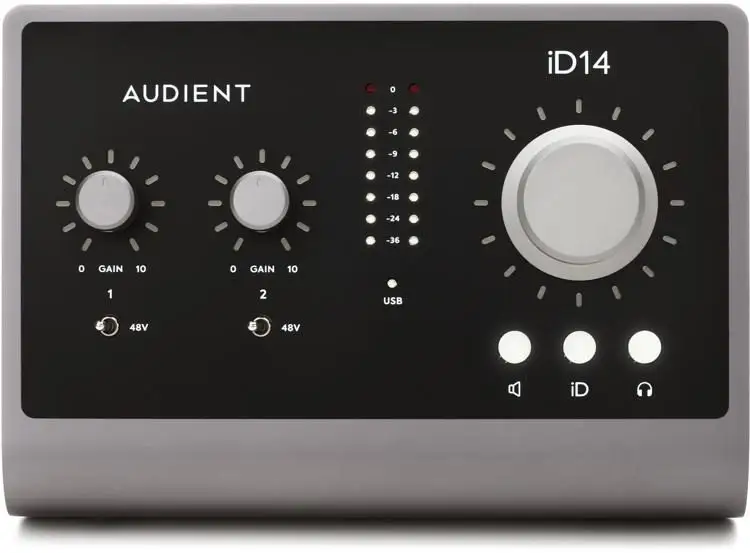
Yes, I know I said the 10 best audio interfaces, but Audient is a bit of a disruptor in the audio field, and it would be remiss of me not to give them a shout-out. Also, they're a British brand so I feel obliged to honor the flag (spellcheck aside).
Don't be fooled by the simple-looking design of this box. Its gunmetal housing hides a whole bunch of features that would be at home in any project studio or mobile recording rig.
A handy 1/4" jack on the front panel allows you to easily plug an instrument in, and around the back, you'll find two XLR/1/4" connections. These inputs are supplemented by the 8-channel ADAT optical input, also housed on the rear side, giving the user plenty of options for additional preamps. In addition to the main speaker outputs, there are also further two line outs for creative routing or additional monitoring.
The USB 3.0 connection provides bus power and data transfer speeds that rival The Flash, and an included USB-C connector cable makes the unit compatible with many tablet devices.
Finally, my favorite feature on this interface is the ability to use the large volume knob on the top of the unit to tweak and control multiple DAW and plugin parameters via Audient's Scroll Control virtual scroll wheel. It's not a replacement for a real control surface, but a handy addition for the mobile user.
Notable Features
- The volume knob can control other DAW parameters
Reasons To Buy
- Excellent value, high-quality audio
- Great mic preamp
Reasons To Avoid
- No MIDI
My Verdict
This isn't the only model Audient offers, so if you need more connectivity poke around and see if something else from the fold fits the bill. But for the mobile or laptop musician with modest input needs, this is dollar for dollar one of the best audio interfaces around.
What Does The Future Hold For Audio Interfaces?
As we march ever-forward in the name of progress there will inevitably be new innovations in audio interfaces. More connectivity. Better compatibility. Crisper converters, and lower latency. Who knows what else?
NAMM is one of the largest industry trade shows and is typically when developers announce their newest and best products. Traditionally it's held every January, and gear-lusting musicians and producers salivate over products yet to be released. As you might expect, the in-person event hasn't happened for a while, but it's set for a big comeback this June. At that point, I imagine we'll get a peek into what the future holds for audio interfaces.
But really, this is about you and the musical journey you're on. So....
Conclusion
What's the best USB audio interface? Perhaps the better question to ask is 'what's the best USB audio interface for me right now ?'. There are so many options to choose from it's easy to get bamboozled in a jungle of spec sheets.
Figure out what you need to do with your interface, decide what you can afford, and go from there. Don't stress about it! Music is a journey and an interface is just one of the tools to help you on your way. You got this.





